Analysis of the Spatial and Temporal Pattern of Changes in Abandoned Farmland Based on Long Time Series of Remote Sensing Data
Abstract
:1. Introduction
2. Study Zone Description and Database
2.1. Study Zone Description
2.2. Dataset Description
2.2.1. Remote Sensing Data
2.2.2. Other Data
- (a)
- Farmland DataFarmland data can be used to avoid errors in image interpretation in the whole region, as well as inconsistencies in patch boundaries for different periods of image interpretation in the same region. According to the phenological characteristics of crops, the boundary of cultivated land is clear in winter, which makes it easier to extract farmland. In this study, a Google Earth image with a resolution of 0.5 m from December 2018 was used to extract farmland by using an artificial digital method (taking full advantage of the high spatial resolution characteristics of Google Earth images, the farmland boundary information was obtained by observing the images, and the farmland boundaries were manually outlined on the image and saved as a vector in the ArcMap 10.3 software) (Figure 2). The abandoned farmland information was extracted based on the farmland data.
- (b)
- Field Survey DataWe obtained 110 field survey points based on the field survey, including 48 in grassland, 13 in cultivated land, and 49 in bare land (Figure 2). This was combined with high-resolution image data from Google Earth to provide the basic data for selecting the training and verification samples.
- (c)
- Digital Elevation Model (DEM) DataThe DEM utilised in this research used ASTER GDEM data (Figure 3) with a resolution of 30 m provided by the Geospatial Data Cloud (http://www.gscloud.cn, accessed on 19 January 2021). In RF classification, it was used as a feature band to improve the accuracy of the classification results. The slope was calculated in Arcmap 10.3 based on the DEM data as one of the feature bands of the RF classification.
- (d)
- High-Resolution Images from Google EarthIn the Google Earth software, according to multi-source data from different years, we adjusted the acquisition year of the Google Earth images and tried to ensure that the acquisition years of the Google Earth images were consistent with the acquisition years of the multi-source data. We acquired a total of 11 Google Earth images from 2010 to 2020 with a resolution of 0.5 m, which were used to extract farmland vector data and as a reference for selecting the training samples and validation samples.
3. Research Methods
3.1. Definition of Abandoned Farmland
3.2. Methodology
- (1)
- Data pre-processing.
- (2)
- Creating a land-use time-series map for the period of 2010–2020.
- (3)
- Accuracy validation.
- (4)
- Establishing rules for identifying abandoned farmland and building an abandonment time-series distribution map for the period of 2011–2020.
- (5)
- Establishing rules for identifying abandoned farmland that was re-cultivated to build a re-cultivation time-series distribution map for the period of 2012–2020.
- (6)
- Analysis of the frequency of abandoned farmland.
3.2.1. Data Pre-Processing
3.2.2. Creating the Land-Use Time-Series Map
3.2.3. Accuracy Validation
3.2.4. Identification and Extraction of Abandoned Farmland
3.2.5. Reclamation Identification and Analysis of the Frequency of Abandoned Farmland
4. Results
4.1. Land-Use Time-Series Map
4.2. Abandoned Farmland
4.3. Recultivation of Abandoned Farmland
4.4. Frequency of Abandoned Farmland
5. Discussion
- (1)
- Definition of abandoned farmland: In addition to the definition of the frequency of abandonment in Section 3.1, some scholars have different standards from diverse perspectives. For example, according to the different degrees of abandoned farmland, the IEEP divided abandoned farmland into completely abandoned, excessively abandoned, and incompletely abandoned farmland [30]; Some scholars divide abandoned farmland into active abandonment and passive abandonment according to different wishes of farmers [31]. Further refinement of this division involves the relative commitment of farmers; from the combination of the abandoned farmland and labour force, this classification can be divided into the expansion of (or increase in) abandoned farmland [32] and the recession of (or decrease in) abandoned farmland [27]. Different definitions of abandoned farmland will produce divergent results. This study only defined and extracted abandoned farmland from the perspective of the frequency of abandonment combined with the local cropping policies and crop phenology. Abandoned farmland should be defined according to local conditions and research purposes in specific areas.
- (2)
- Remote sensing image classification error transfer: In the process of remote sensing classification, the plots interpreted as grassland by remote sensing may contain other crops. This is particularly the case in spring, when crop land appears similar to grassland. This can result in incorrect classification; however, this is not a problem in autumn when the crops are easily distinguished from grassland. In this experiment, the detection of the changes in the vegetation index for spring and autumn and the spring image classification results were superimposed to minimise the incorrect classification of grassland and cultivated land, as well as the phenomenon of the non-identification of cultivated land. Because of the complexity of the phenomenon of abandoned farmland, it is difficult to identify abandoned farmland directly by using remote sensing images. In this experiment, the entire study area was interpreted through remote sensing, and the recognition rules for abandoned farmland were then determined. Thereafter, the abandoned farmland data were extracted. The classification errors evident in the remote sensing image classification were transferred to the extraction of the subsequently abandoned farmland, resulting in errors in the abandoned farmland extraction; such errors are difficult to eliminate. The abandoned farmland extraction error can be reduced by improving the classification accuracy of remote sensing images.
- (3)
- Precision validation: The abandonment of farmland does not involve a single type of land, such as areas buildings and water, but rather results in a change in the type of cultivated land. It is difficult to obtain verification data through the visual interpretation of location, texture, colour, and other characteristics. Real verification requires data on actual cultivated land that has been abandoned. However, there are insufficient available historical statistical data on the abandonment of farmland. Furthermore, the accuracy of the extraction of abandoned farmland data can only be indirectly confirmed by verifying the accuracy of land classification results; thus, the precision validation method needs improvement.
6. Conclusions
- (1)
- A land-use time-series map for Luquan from 2010 to 2020 was obtained by using RF classification and NDVI detection methods; the overall classification accuracy was between 91.81% and 96.92%, and the kappa coefficient was in the range of 0.89–0.96, which is highly accurate and can be used as the basic data for abandoned farmland identification.
- (2)
- From 2011 to 2020, the maximum abandoned area was 3906.02 hm2, and the minimum was 1618.74 hm2. The highest and lowest abandonment rates were 14.09% and 5.83%, respectively. From 2012 to 2017, the abandonment rate was comparatively high at more than 10%. In recent years, the abandonment rate has declined. During the monitoring period, the abandoned area showed a trend of first increasing and then decreasing in the study area.
- (3)
- From 2012 to 2020, the maximum reclamation area of abandoned farmland was 291.49 hm2, and the minimum was 34.94 hm2. The highest reclamation rate was 14.26%, the lowest was 0.95%, and the annual average reclamation rate was 4.67%. The overall reclamation rate was low, with reclamation mainly being concentrated in the plain areas, which are suited to cultivation; in contrast, the abandoned cultivated land in the western mountainous areas showed almost no signs of reclamation.
- (4)
- The areas with a high frequency of abandonment were mainly concentrated in the western mountainous area of Luquan, while the eastern plain had a relatively low frequency of abandonment. The area of abandoned farmland gradually decreased as the frequency of abandoned farmland increased.
Author Contributions
Funding
Data Availability Statement
Acknowledgments
Conflicts of Interest
References
- Tian, Y.; Li, X.; Ma, G. Influences of labor emigration from agriculture on the production abandonment of cultivated land in ecological sensitive areas. China Land Sci. 2010, 24, 4–9. [Google Scholar]
- Liu, G.; Wang, H.; Cheng, Y. Impact of rural out-migration on arable land use intensity: Evidence from mountain areas in Guangdong, China. Land Use Pol. 2016, 59, 569–579. [Google Scholar] [CrossRef]
- Li, S.; Li, X. Progress and prospect on farmland abandonment. Acta Geogr. Sin. 2016, 71, 370–389. (In Chinese) [Google Scholar]
- Yan, J.; Yang, Z.; Li, Z.; Li, X.; Xin, L.; Sun, L. Drivers of cropland abandonment in mountainous areas: A household decision model on farming scale in Southwest China. Land Use Pol. 2016, 57, 459–469. [Google Scholar] [CrossRef] [Green Version]
- Zhang, Y.; Li, X.; Song, W. Determinants of cropland abandonment at the parcel, household and village levels in mountain areas of China: A multi-level analysis. Land Use Pol. 2014, 41, 186–192. [Google Scholar] [CrossRef]
- Li, S.; Li, X.; Sun, L.; Cao, G.; Fischer, G.; Tramberend, S. An estimation of the extent of cropland abandonment in mountainous regions of China. Land Degrad. Dev. 2018, 29, 1327–1342. [Google Scholar] [CrossRef]
- Li, X.; Zhao, Y. Forest Transition, Agricultural land marginalization and ecological restoration. China Popul. Resour. Environ. 2011, 21, 91–95. [Google Scholar]
- Deng, X.; Xu, D.; Zeng, M.; Qi, Y. Landslides and Cropland Abandonment in China’s Mountainous Areas: Spatial Distribution, Empirical Analysis and Policy Implications. Sustainability 2018, 10, 3390. [Google Scholar] [CrossRef] [Green Version]
- Xiao, G.; Zhu, X.; Hou, C.; Xia, X. Extraction and analysis of Abandoned Farmland: A case study of Qingyun county and Wudi County in Shandong Province. Acta Geogr. Sinica 2019, 73, 1658–1673. (In Chinese) [Google Scholar] [CrossRef] [Green Version]
- Cibele, Q.; Ruth, B.; Carl, F.; Regina, L. Farmland Abandonedz: Threat or Opportunity for Biodiversity Conservation? A Global Review. Front. Ecol. Environ. 2014, 12, 288–296. [Google Scholar]
- Molinillo, M.; Lasanta, T.; García-Ruiz, J.M. RESEARCH: Managing Mountainous Degraded Landscapes After Farmland Abandonment in the Central Spanish Pyrenees. Environ. Manag. 1997, 21, 587–598. [Google Scholar] [CrossRef]
- Bakker, M.M.; Govers, G.; van Doorn, A.; Quetier, F.; Chouvardas, D.; Rounsevell, M. The Response of Soil Erosion and Sediment Export to Land-use Change in Four Areas of Europe: The Importance of Landscape Pattern. Geo Morphol. 2008, 98, 213–226. [Google Scholar] [CrossRef]
- Batllebayer, L.; Batjes, N.H.; Bindraban, P.S. Changes in Organic Ca-rbonStocks upon Land Use Conversion in the Brazilian Cerrado: A Review. Agric. Ecosyst. Environ. 2010, 137, 47–58. [Google Scholar] [CrossRef]
- Vuichard, N.; Ciais, P.; Belelli, L.; Smith, P.; Valentini, R. Carbon Sequestration Due to the Abandoned of Agriculture in the Former USSR Since 1990. Glob. Biogeochem. Cycles 2008, 22, 1417–1430. [Google Scholar] [CrossRef]
- MacDonald, D.; Crabtree, J.R.; Wiesinger, G.; Dax, T.; Stamou, N.; Fleury, P.; Gutierrez Lazpita, J.; Gibon, A. Agricultural Aban-donment in Mountain Areas of Europe: Environmental Consequences and Policy Response. J. Environ. Manag. 2000, 59, 47–69. [Google Scholar] [CrossRef]
- Xie, H.; Wang, P.; Yao, G. Exploring the Dynamic Mechanisms of Farmland Abandonment Based on a Spatially Explicit Economic Model for environmental Sustainability. Sustainability 2014, 6, 1260–1282. [Google Scholar] [CrossRef] [Green Version]
- Dong, J.; Liu, J.; Yan, H.; Tao, F.; Kuang, W. Spatio-temporal Pattern and Rationality of Land Reclamation and Cropland Abandonment in Mid-eastern Inner Mongolia of China in 1990–2005. Environ. Monit. Assess. 2011, 179, 137–153. [Google Scholar] [CrossRef]
- Li, Z.; Yan, J.; Hua, X.; Xin, L.; Li, X. Study on abandonment of different types of farmers and its influencing factors: A case study of 12 typical villages in Chongqing. Geogr. Res. 2014, 33, 721–734. (In Chinese) [Google Scholar]
- Song, S.; Liang, X.; Chen, H.; Mao, N. Simulation of cultivated land abandonment based on Multi-Agent and land conversion model: A case study of Mizhi County, Shaanxi Province. J. Nat. Resour. 2018, 33, 515–525. (In Chinese) [Google Scholar]
- Witmer, F.D.W. Detecting War-induced Abandoned Agricultural Land in Northeast Bosnia Using Multispectral, Multitemporal Landsat TM Imagery. Int. J. Remote Sens. 2008, 29, 3805–3831. [Google Scholar] [CrossRef]
- Cheng, W.; Zhou, Y.; Wang, S.; Han, Y.; Wang, F.; Pu, Q. Study on abandoned farmland identification based on Multispectral Remote Sensing. Spectrosc. Spectr. Anal. 2011, 31, 1615–1620. (In Chinese) [Google Scholar]
- Niu, J.; Lin, H.; Niu, Y.; Fan, Y.; Tang, W. Analysis on spatial pattern and driving factors of abandoned farmland in economically underdeveloped areas. J. Agric. Mach. 2017, 48, 146–154. (In Chinese) [Google Scholar]
- Yang, T.; Guo, X.; Yue, D.; Wang, X.; Han, S. Extraction of cultivated land abandonment information based on joint change detection and analysis of driving factors. Acta Agric. Mech. Sinica 2019, 50, 201–208. (In Chinese) [Google Scholar]
- Xu, M. Food and Agriculture Organization of the United Nations. In Selected Indicators of Food and Agriculture Development in Asia Pacific Region: 1996–2006; China Agriculture Press: Beijing, China, 2009; pp. 89–90. (In Chinese) [Google Scholar]
- Shi, T.; Li, X. Research on cultivated land abandonment in Europe and Its Enlightenment to China. Geogr. Geogr. Inf. Scienc 2013, 29, 101–103. (In Chinese) [Google Scholar]
- Song, S.; Liang, X.; Mei, Y.; Wen, X.; Wang, Y.; Mao, N. Construction and Simulation of farmers’ cultivated land abandonment behavior model based on CBDI: A case study of fengyangdi village, Mizhi County, Shanxi Province. J. Nat. Resour. 2016, 31, 1926–1937. (In Chinese) [Google Scholar]
- Shen, S. Study on the Problem of Agricultural Land Abandonment in Western Poor Mountainous Areas; Capital University of Economics and Trade: Beijing, China, 2017. (In Chinese) [Google Scholar]
- Ding, R.; Zhang, E.; Xie, Z.; Ji, W.; Shao, H. Extraction and analysis of abandoned farmland in Hebei Shandong Henan provincial border area. Hubei Agric. Sci. 2019, 58, 122–128. (In Chinese) [Google Scholar]
- Wei, S. Mapping Cropland Abandonment in Mountainous Areas Using an Annual Land-Use Trajectory Approach. Sustainability 2019, 11, 5951. [Google Scholar]
- Clunie, K.; Graham, T. Farmland Abandonment in the EU: An Assessment of Trends and Prospects; Report Prepared for WWF; WWF: Zeist, The Netherlands, 2010; pp. 20–40. [Google Scholar]
- Feng, Y.; Dong, Y.; Wang, F. Analysis on abandonment behavior and influencing factors of farmers in suburbs of big cities: A case study of farmers in Panyu District of Guangzhou. J. Nat. Resour. 2010, 25, 722–734. (In Chinese) [Google Scholar]
- Huang, J.; Li, L. Analysis of cultivated land abandonment behavior from the perspective of rural labor force: An Empirical Study Based on rural areas of Huitong County. J. Beijing Univ. Technol. (Soc. Sci. Ed.) 2009, 11, 42–47. (In Chinese) [Google Scholar]

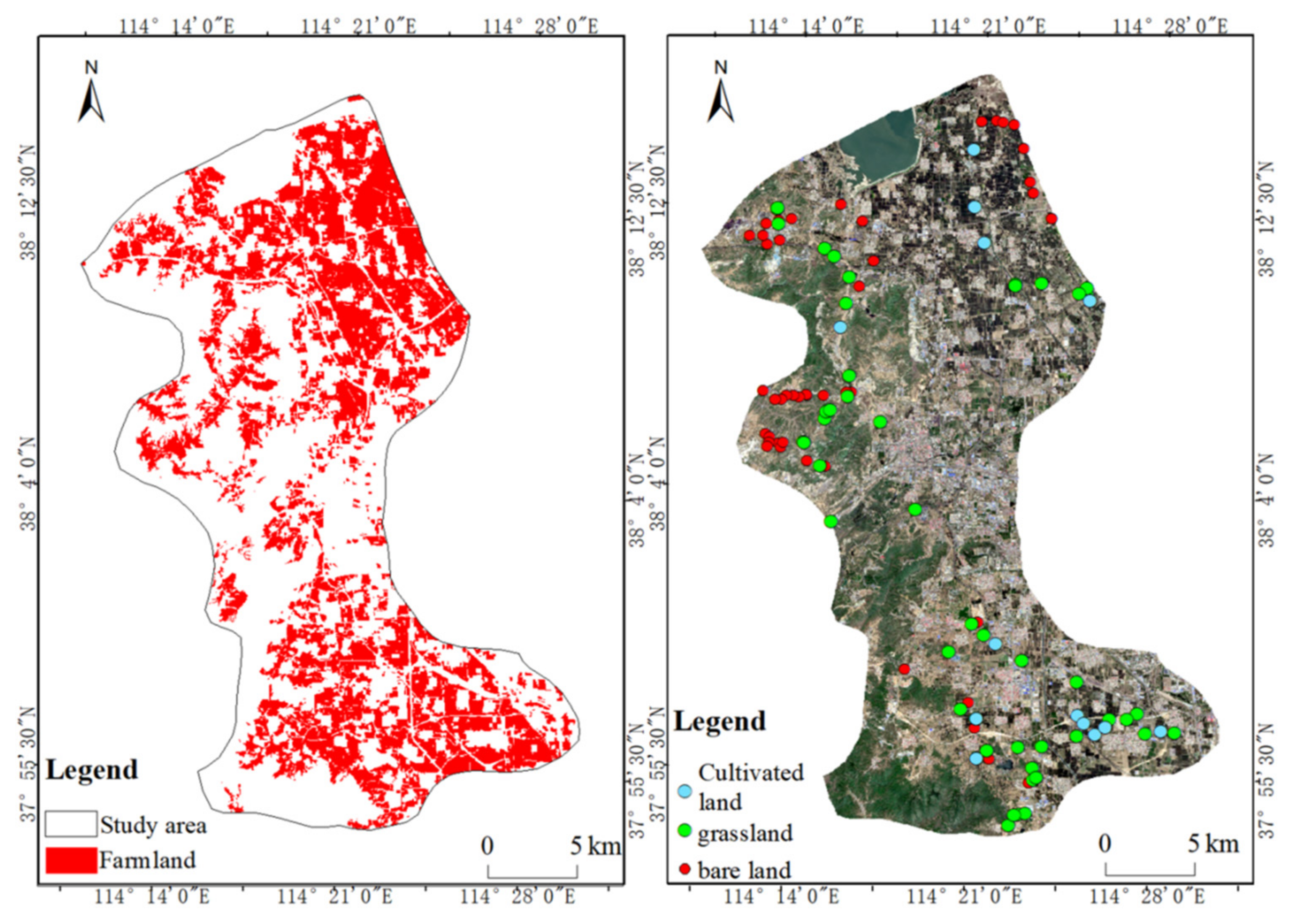
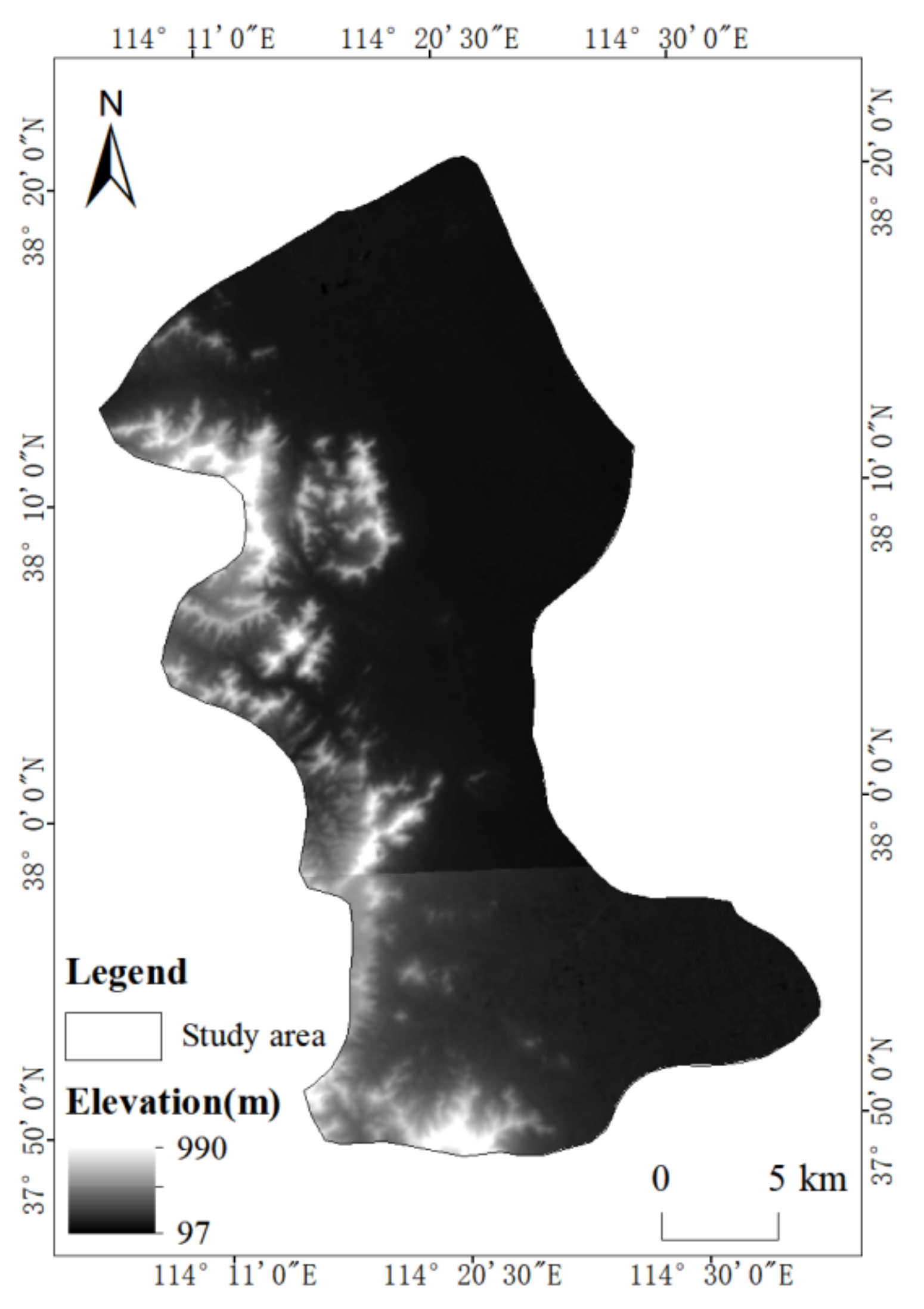


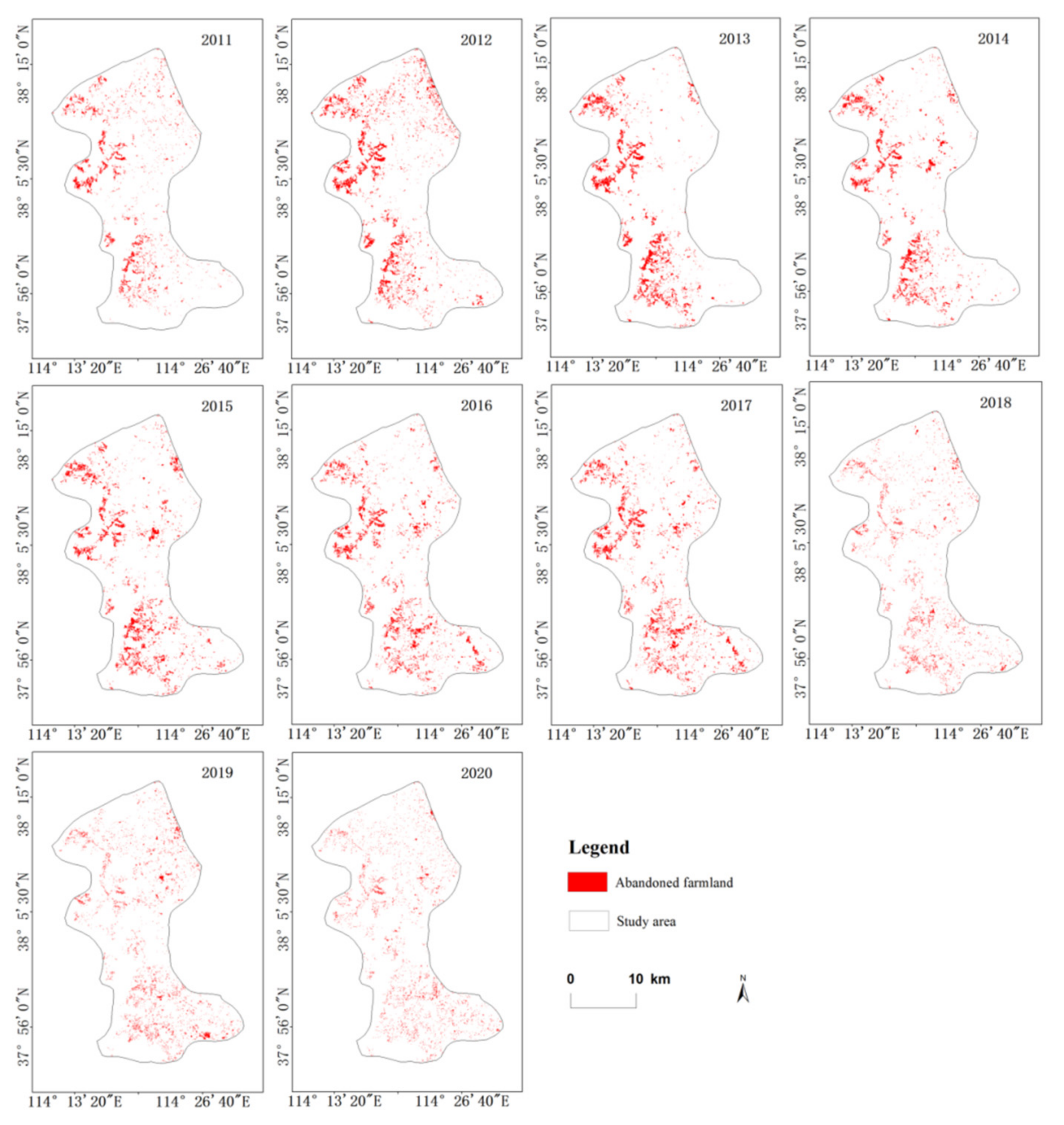

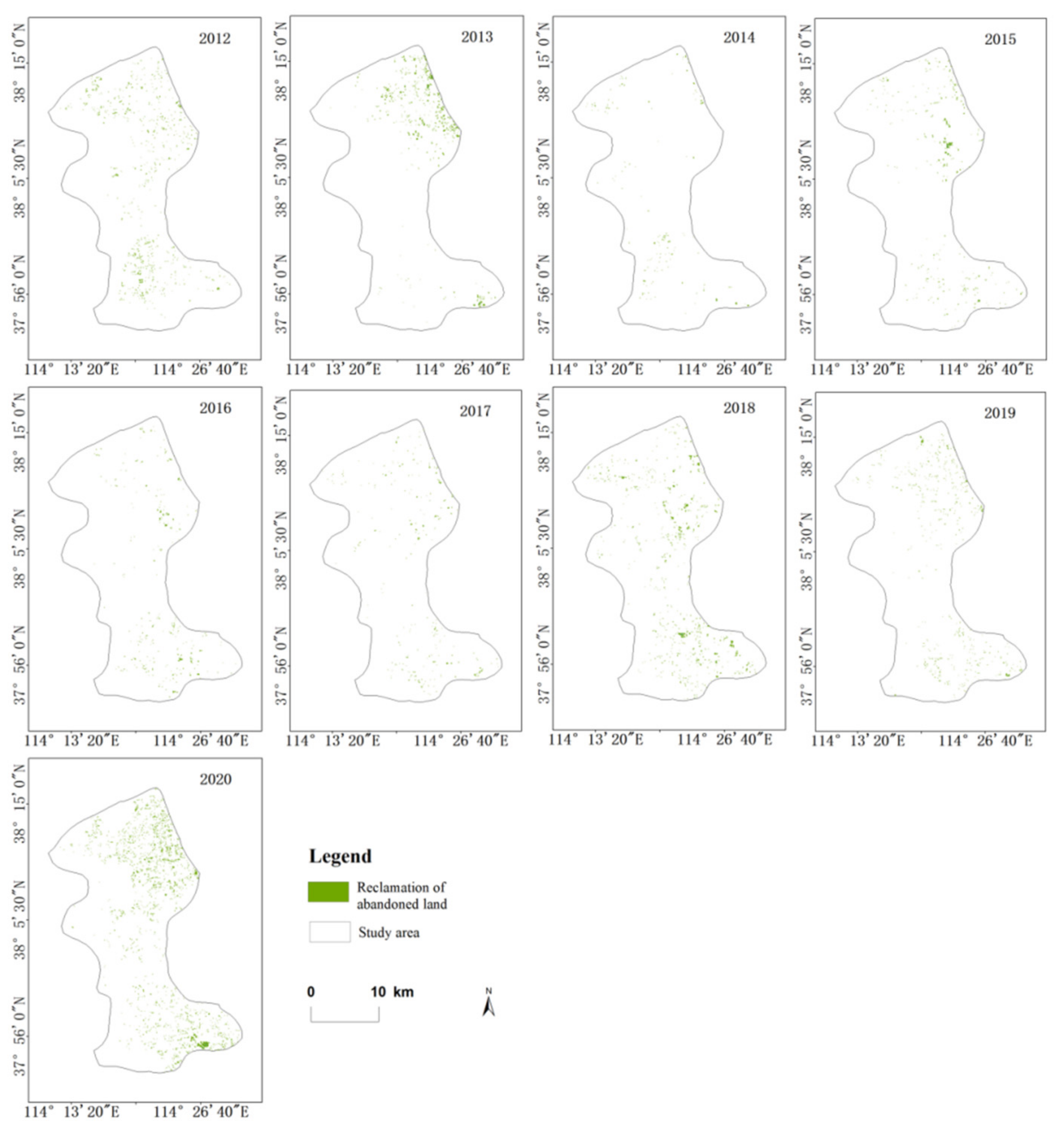
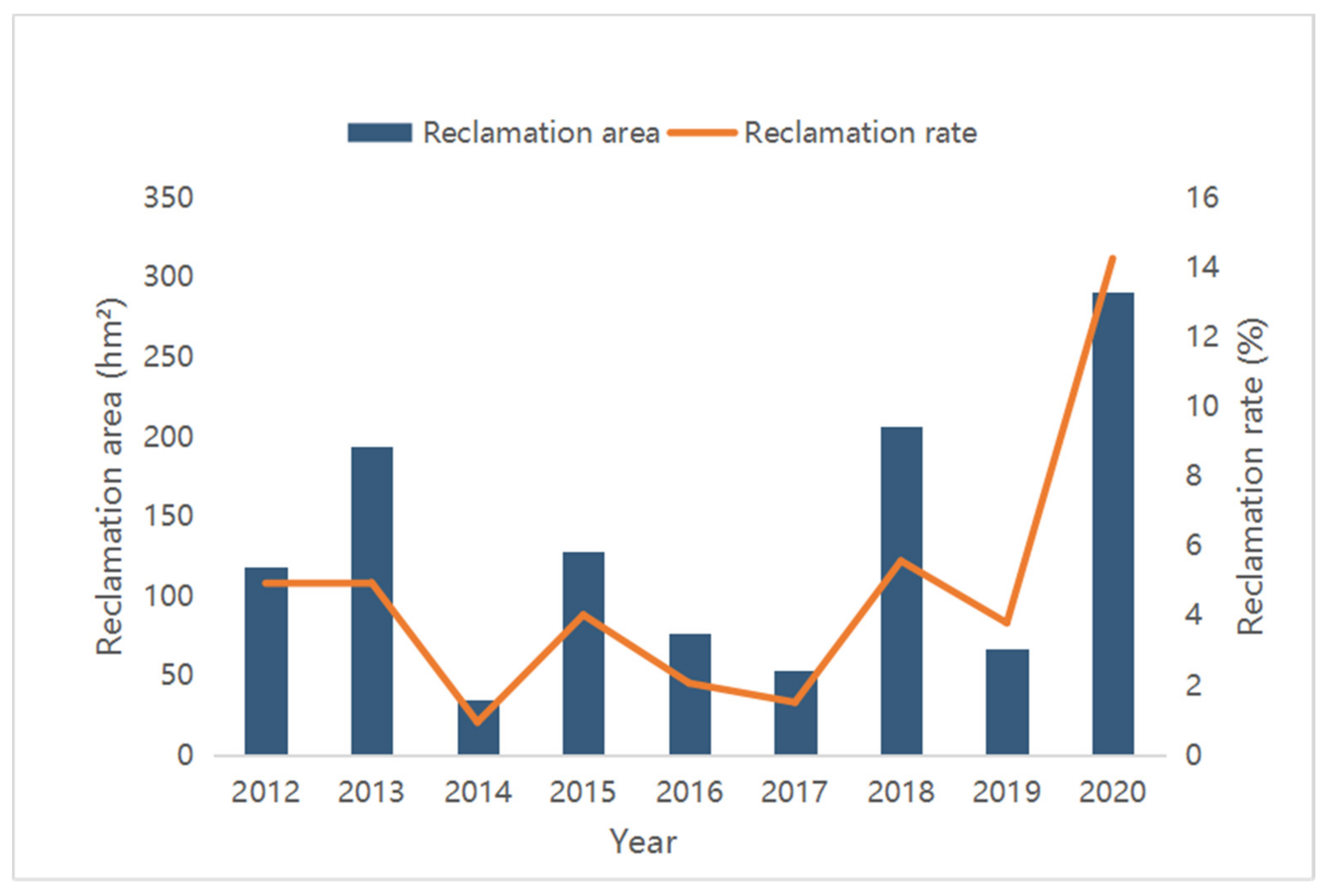
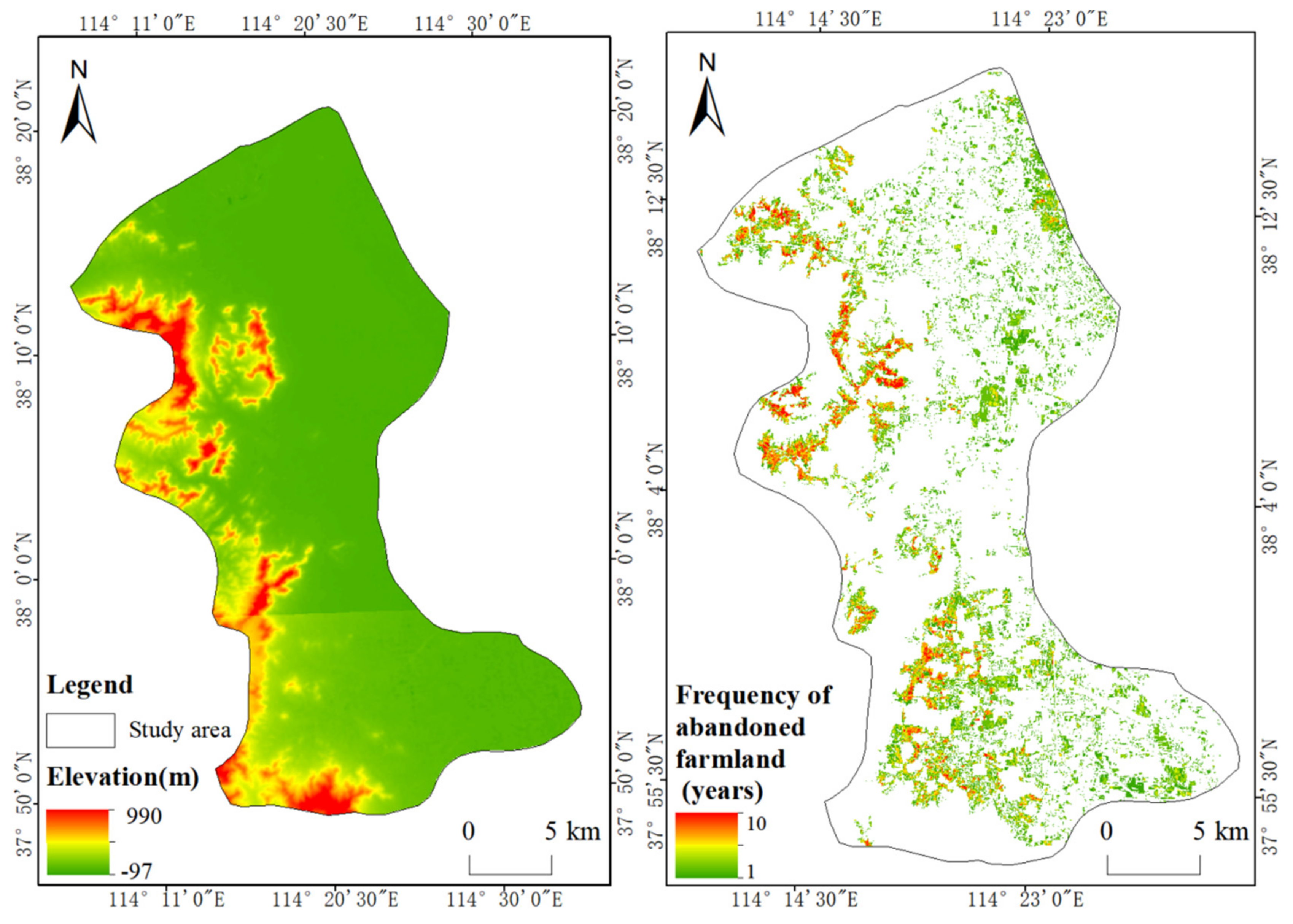

| Year | Satellite | Period | Cloud Coverage | ||
|---|---|---|---|---|---|
| Period 1 | Period 2 | Period 1 | Period 2 | ||
| 2010 | Landsat-7 | 19th May | 6th July | 0% | 1.58% |
| 2011 | Landsat-7 | 6th May | 25th July | 0.37% | 0.71% |
| 2012 | Landsat-7 | 6th April | 9th June | 0.03% | 1.83% |
| 2013 | Landsat-8 | 19th May | 6th July | 0.07% | 0.47% |
| 2014 | Landsat-8 | 22nd May | 6th July | 0.16% | 0.19% |
| 2015 | Landsat-8 | 25th May | 12th July | 0.84% | 0.36% |
| 2016 | Landsat-8 | 25th April | 12th June | 0.04% | 0.02% |
| 2017 | Sentinel-2 | 28th May | 27th June | 0.89% | 0.01% |
| 2018 | Sentinel-2 | 28th May | 12th June | 0.28% | 0% |
| 2019 | Sentinel-2 | 28th May | 12th July | 1.97% | 2.31% |
| 2020 | Sentinel-2 | 27th May | 6th July | 0.56% | 0.40% |
| Year | Random Forest Classification | Random Forest Classification (Superimposed Change Detection Results) | ||
|---|---|---|---|---|
| Overall Accuracy | Kappa Coefficient | Overall Accuracy | Kappa Coefficient | |
| 2010 | 87.12% | 0.8300 | 92.82% | 0.91 |
| 2011 | 87.24% | 0.8349 | 95.35% | 0.93 |
| 2012 | 90.98% | 0.8837 | 95.93% | 0.94 |
| 2013 | 94.31% | 0.9178 | 96.92% | 0.96 |
| 2014 | 87.53% | 0.8435 | 92.70% | 0.91 |
| 2015 | 89.53% | 0.8667 | 90.20% | 0.87 |
| 2016 | 84.84% | 0.8053 | 93.66% | 0.91 |
| 2017 | 84.68% | 0.8092 | 95.59% | 0.93 |
| 2018 | 81.69% | 0.7714 | 96.68% | 0.95 |
| 2019 | 81.18% | 0.7647 | 92.62% | 0.90 |
| 2020 | 81.53% | 0.7687 | 91.81% | 0.89 |
| Year | Abandoned Area (hm2) | Abandonment Rate (%) | Year | Abandoned Area (hm2) | Abandonment Rate (%) |
|---|---|---|---|---|---|
| 2011 | 2402.24 | 8.66 | 2016 | 3522.90 | 12.70 |
| 2012 | 3906.02 | 14.09 | 2017 | 3708.16 | 13.37 |
| 2013 | 3648.46 | 13.16 | 2018 | 1752.55 | 6.32 |
| 2014 | 3170.35 | 11.43 | 2019 | 2043.91 | 7.37 |
| 2015 | 3693.50 | 13.32 | 2020 | 1618.74 | 5.83 |
| Year | Reclamation Area (hm2) | Reclamation Rate (%) | Year | Reclamation Area (hm2) | Reclamation Rate (%) |
|---|---|---|---|---|---|
| 2012 | 118.87 | 4.94 | 2017 | 53.81 | 1.52 |
| 2013 | 193.95 | 4.96 | 2018 | 207.06 | 5.58 |
| 2014 | 34.94 | 0.95 | 2019 | 66.61 | 3.80 |
| 2015 | 127.95 | 4.03 | 2020 | 291.49 | 14.26 |
| 2016 | 76.36 | 2.07 |
| Abandonment Frequency (Years/Years) | Abandoned Area (hm2) | Abandonment Frequency (Years/Years) | Abandoned Area (hm2) |
|---|---|---|---|
| 1/10 | 4261.07 | 6/10 | 575.10 |
| 2/10 | 2556.94 | 7/10 | 534.56 |
| 3/10 | 1375.72 | 8/10 | 173.80 |
| 4/10 | 880.57 | 9/10 | 109.74 |
| 5/10 | 755.49 | 10/10 | 33.04 |
Publisher’s Note: MDPI stays neutral with regard to jurisdictional claims in published maps and institutional affiliations. |
© 2021 by the authors. Licensee MDPI, Basel, Switzerland. This article is an open access article distributed under the terms and conditions of the Creative Commons Attribution (CC BY) license (https://creativecommons.org/licenses/by/4.0/).
Share and Cite
Wei, Z.; Gu, X.; Sun, Q.; Hu, X.; Gao, Y. Analysis of the Spatial and Temporal Pattern of Changes in Abandoned Farmland Based on Long Time Series of Remote Sensing Data. Remote Sens. 2021, 13, 2549. https://doi.org/10.3390/rs13132549
Wei Z, Gu X, Sun Q, Hu X, Gao Y. Analysis of the Spatial and Temporal Pattern of Changes in Abandoned Farmland Based on Long Time Series of Remote Sensing Data. Remote Sensing. 2021; 13(13):2549. https://doi.org/10.3390/rs13132549
Chicago/Turabian StyleWei, Zhonghui, Xiaohe Gu, Qian Sun, Xueqian Hu, and Yunbing Gao. 2021. "Analysis of the Spatial and Temporal Pattern of Changes in Abandoned Farmland Based on Long Time Series of Remote Sensing Data" Remote Sensing 13, no. 13: 2549. https://doi.org/10.3390/rs13132549






